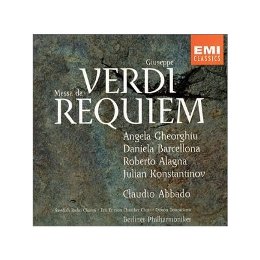Giuseppe Verdi – Messa da Requiem (Abbado) [1991]
Giuseppe Verdi – Messa da Requiem (Abbado) [1991]

1. Requiem
2. Dies Irae
3. Tuba Mirum
4. Liber Scriptum
5. Quid Sum Miser
6. Rex Tremendae
7. Recordare
8. Ingemisco
9. Confutatis
10. Lacrymosa
11. Offertorio
12. Sanctus
13. Agnus Dei
14. Lux Aeterna
15. Libera Me
Angela Gheorghiu (sop) Daniela Barcellona (mezzo) Roberto Alagna (tenor) Julian Konstantinov (bass) Vienna PO & State Opera Choir Claudio Abbado – director
That Verdi's Messa da Requiem should be infused with the dramatic power of the his operas is no surprise. The text of the requiem is the most dramatic Verdi ever set, allowing him to explore his new ability to compose large sections of music on a "symphonic" scale with powerful passages for chorus and orchestra.
As much as Verdi lamented the death of Gioachino Rossini (1792-1868), he was more moved by the death of novelist Alessandro Manzoni in 1873. When Rossini died, Verdi felt that only Manzoni remained of Italy's great tradition. After Manzoni died, Verdi wrote to Contessa Maffei, "Now all is over! And with him ends...the greatest of our glories." When Verdi and Manzoni met in 1848, Verdi described the experience as one of being in the presence "of a saint." It was for Manzoni that Verdi composed his requiem.
From the very beginning, Verdi's Requiem was intended for the concert hall, not the church. This gave the composer some freedom when setting the text, although he remained much more faithful to the standard liturgy than did Berlioz in his setting. Verdi's Requiem was first performed on May 22, 1874, in Milan, on the first anniversary of Manzoni's death.
Verdi conveys the solemnity of the Requiem Mass through the opening cello line, a muted, descending phrase. The orchestra has the thematic material in the first part of the Introit, "Requiem aeternam," as the chorus sings the text in snatches. To balance this, the central part of the movement, "Te decet hymnus," is for unaccompanied chorus. After the return of the "Requiem aeternam" the Kyrie begins, introducing the soloists.
The "Dies irae," opening the Sequence, is the most famous part of Verdi's Requiem. Brass and bass drum make their first appearance in this tumultuous outburst depicting the "day of wrath." Distant trumpets sound and are joined by the rest of the brass before the "Tuba mirum." Quietly, the solo bass begins the "Mors stupebit" (Death is struck), accompanied by pizzicato basses and bass drum. After the solo mezzo-soprano delivers the "liber scriptus proferetur," the chorus bursts in with a reprise of the "Dies irae," an event dictated by musical considerations that has nothing to do with the requiem mass text. For the "Lacrimosa," Verdi extended and rewrote a duet for Don Carlos and King Philip he had cut from Don Carlos before its premiere. Like Cherubini, Verdi unites the Sanctus and Benedictus.
Verdi composed the concluding "Libera me," for soprano, chorus, and orchestra in 1868-1869 as his part of a collaborative requiem for Rossini, the remaining sections of which were to be set by other Italian composers. The project came to nothing, but Verdi kept his "Libera me" and eagerly seized the opportunity to use it as part of a complete requiem. After the solo soprano begins the movement, the chorus again intercedes with the "Dies irae," which is followed by a beautiful reprise of the "Requiem aeternam" and a closing, fugal setting of the "Libera me." ---John Palmer, Rovi
download: uploaded yandex 4shared mediafire solidfiles mega zalivalka filecloudio anonfiles oboom
Last Updated (Monday, 16 June 2014 08:45)








